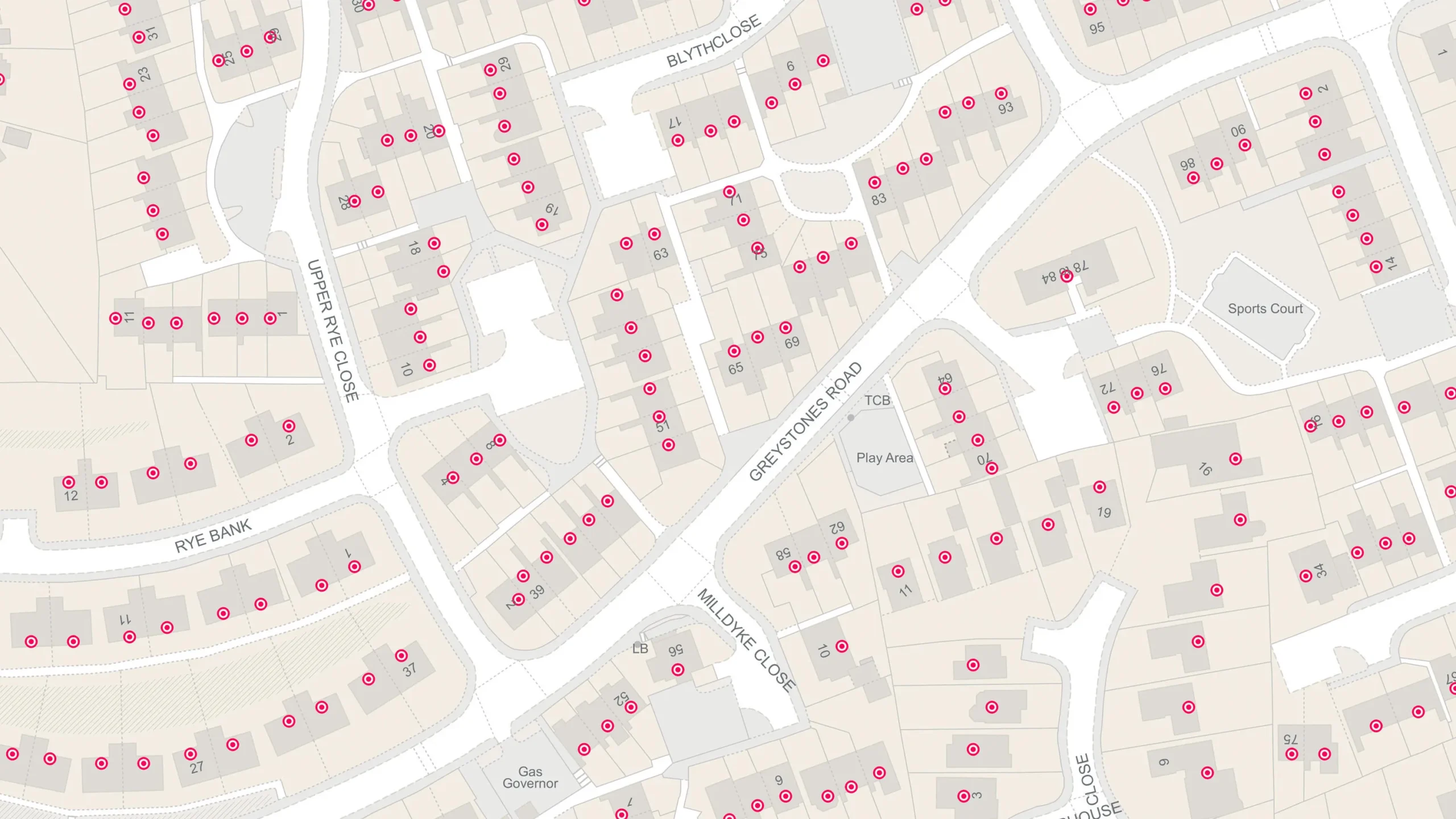
AddressBase Premium vs AddressBase Core comparison
AddressBase Premium and AddressBase Core represent two different approaches to address data provision from Ordnance Survey. While both provide comprehensive address coverage for Great Britain, they differ significantly in data depth, complexity, and intended use cases. Premium offers complete lifecycle information and relational data structures, whereas Core provides simplified, plug-and-play access to essential address data.
Product Overview
AddressBase Premium
AddressBase Premium provides the most detailed view of an address and its lifecycle for England, Wales, and Scotland. It contains the complete history of every address from creation to retirement, offering the richest addressing dataset available from Ordnance Survey.
AddressBase Core
AddressBase Core is a simple, accessible addressing data product designed for plug-and-play access to complete, accurate address data. It represents the newest member of the AddressBase product family, being lightweight, easy to load, and frequently updated.
Key Differences
Data Structure and Complexity
AddressBase Premium:
- Structured as a series of relational tables
- Complex data structure described by Unified Modeling Language (UML) class diagrams
- Requires additional processing for simplistic tasks
- Contains all information relating to an address from creation to retirement
- More records than AddressBase Plus due to complete lifecycle coverage
AddressBase Core:
- Simple, flat file structure
- Plug-and-play accessibility
- Lightweight and easy to load
- Streamlined for immediate use without complex processing
- 33 million live address records with coordinates and UPRNs
Data Coverage and Content
AddressBase Premium:
- Full lifecycle information for all properties
- Historical address data included
- Contains Local Authority information
- Provides comprehensive address relationship data
- Includes retired and historical addresses
- More detailed classification and attribution
AddressBase Core:
- Current, live addresses only
- Essential address components
- Basic coordinate information
- UPRN (Unique Property Reference Number) included
- Focused on active addresses without historical context
Update Frequency
AddressBase Premium:
- Updated every six weeks (known as an epoch)
- Follows the standard AddressBase update cycle
- Changes processed in batches
AddressBase Core:
- Weekly supply schedule
- More frequent updates than Premium
- Separate release notes from other AddressBase products
- Faster incorporation of address changes
Use Cases and Applications
AddressBase Premium:
- Ideal for applications requiring complete address lifecycle information
- Suitable for complex GIS and database systems
- Perfect for historical analysis and property research
- Best for applications needing detailed address relationships
- Recommended for comprehensive addressing solutions
- Suitable for large-scale enterprise applications requiring full data depth
AddressBase Core:
- Perfect for basic address validation and lookup
- Ideal for applications needing quick integration
- Suitable for e-commerce and delivery applications
- Best for systems requiring minimal processing overhead
- Recommended for straightforward addressing needs
- Perfect for small to medium-sized applications
Data Processing Requirements
AddressBase Premium:
- Requires significant processing power and storage
- Complex data relationships need careful handling
- May require database expertise for optimal implementation
- Suitable for organizations with robust data infrastructure
- Additional processing required for simple address lookups
AddressBase Core:
- Minimal processing requirements
- Simple to implement and maintain
- Can be easily integrated into existing systems
- Suitable for organizations with limited technical resources
- Ready-to-use format for immediate deployment
Geographic Coverage
Both products provide coverage for:
- England
- Wales
- Scotland
For Northern Ireland, Isle of Man, and Channel Islands coverage, AddressBase Islands would be required as a separate product.
Data Quality and Completeness
AddressBase Premium:
- Most comprehensive addressing dataset available
- Includes quality indicators and confidence levels
- Contains detailed provenance information
- Provides multiple address classifications
- Includes validation status indicators
AddressBase Core:
- High-quality current addresses
- Essential accuracy for operational use
- Simplified quality indicators
- Focus on active, validated addresses
- Streamlined for reliability without complexity
Technical Considerations
Storage Requirements
- Premium: Significantly larger due to historical data and complex structure
- Core: Smaller footprint, optimized for efficiency
Integration Complexity
- Premium: Complex integration requiring technical expertise
- Core: Simple integration with minimal technical requirements
Performance Impact
- Premium: May impact performance due to data volume and complexity
- Core: Optimized for fast query performance and minimal resource usage
Cost Considerations
While specific pricing isn’t detailed in the search results, generally:
- Premium products typically carry higher licensing costs due to comprehensive data
- Core products are usually more cost-effective for basic requirements
- Organizations should evaluate their specific needs against the feature set
Decision Framework
Choose AddressBase Premium if:
- Complete address lifecycle information is required
- Historical address data is needed
- Complex address relationships must be maintained
- Working with comprehensive GIS or enterprise systems
- Detailed address classification is necessary
- Budget allows for comprehensive solution
Choose AddressBase Core if:
- Only current address data is needed
- Quick implementation is priority
- Simple address validation/lookup is sufficient
- Working with limited technical resources
- Budget constraints require cost-effective solution
- Frequent updates are valued over historical depth
Comparison Table
| Feature | AddressBase Premium | AddressBase Core |
|---|---|---|
| Data Structure | Complex relational tables with UML class diagrams | Simple, flat file structure |
| Data Volume | ~33 million records plus historical data | 33 million live address records |
| Address Coverage | Current + historical + retired addresses | Current, live addresses only |
| Update Frequency | Every 6 weeks (epoch-based) | Weekly updates |
| Implementation Complexity | High – requires technical expertise | Low – plug-and-play |
| Processing Requirements | Significant processing and storage needed | Minimal processing required |
| File Size | Large (due to historical data) | Lightweight and optimized |
| Historical Data | Complete lifecycle information | Current addresses only |
| UPRN Included | Yes | Yes |
| Coordinates | Yes (detailed) | Yes (basic) |
| Local Authority Info | Comprehensive | Basic |
| Address Classification | Detailed classification | Simplified classification |
| Quality Indicators | Detailed with confidence levels | Basic quality indicators |
| Integration Speed | Slower (complex setup) | Fast (immediate deployment) |
| Ideal for Small Business | Overly complex | Perfect fit |
| Ideal for Enterprise | Comprehensive solution | May lack depth |
| Cost | Higher licensing fees | More cost-effective |
| Technical Support Needed | High | Low |
| Query Performance | Slower (large dataset) | Faster (optimized) |
| Storage Requirements | High | Moderate |
Quick Selection Guide
| Your Requirement | Recommended Product |
|---|---|
| Basic address validation | AddressBase Core |
| E-commerce delivery | AddressBase Core |
| Historical property research | AddressBase Premium |
| GIS applications (complex) | AddressBase Premium |
| CRM address cleanup | AddressBase Core |
| Property lifecycle tracking | AddressBase Premium |
| Quick implementation needed | AddressBase Core |
| Complete address relationships | AddressBase Premium |
| Limited technical resources | AddressBase Core |
| Maximum data depth required | AddressBase Premium |
Conclusion
The choice between AddressBase Premium and AddressBase Core depends primarily on the depth of address information required and the technical capabilities of the implementing organization. Premium offers unmatched comprehensiveness for complex applications requiring full address lifecycle data, while Core provides an efficient, accessible solution for standard addressing needs. Organizations should carefully evaluate their specific requirements, technical capabilities, and budget constraints when making this decision.
Both products maintain Ordnance Survey’s high standards for data quality and accuracy, ensuring reliable addressing solutions regardless of which option is selected.

